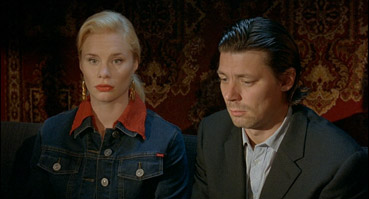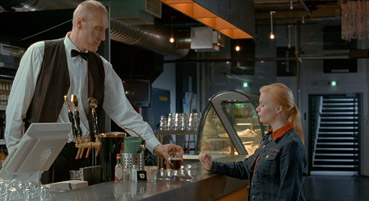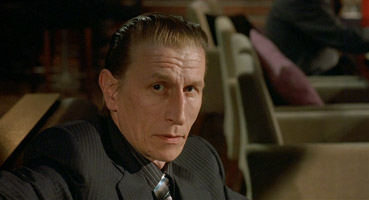|
I'm
always surprised at the uncertainty with which some commentators
approach the films of Finnish director Aki Kaurismäki.
This has to be partly down to cultural differences
in our humour, particularly the mode of its
delivery. The antithesis of the brash approach that has
dominated American film comedy in recent years, Kaurismäki's
films offer a working definition of the term deadpan. More
than one review of his latest, Lights in the Dusk [Laitakaupungin valot], has expressed uncertainty
about where the dividing line lies between the film's dramatic
and comedic elements, since both are pitched at the same
level of surface gloom.
It's
not the first time I've encoutered such confusion regarding
the director's work – in the 13 years of the existence of
the film society I co-run, his wonderful 1996 Drifting
Clouds [Kauas pilvet karkaavat] attracted our smallest ever audience, the prospect of a
cold winter's evening spent in the company of a group of
cheerless Finns proving a too daunting prospect for an audience
that regularly complains that we don't show enough comedies.
I've never had such problems with Kaurismäki's work,
perhaps because I appear to share both his sense of humour
and dour world view. But the cultural element should never
be underestimated. I have two Finnish friends of persistently
cheerful and outgoing disposition who adore Kaurismäki's
films and go into fits of giggles whenever they recall scenes
from them. I'm sure Kaurismäki himself would be amused
to know that they are both dentists.

Lights
in the Dusk is claimed by commentators and by Kaurismäki
himself to be the third film in a trilogy that began with Drifting Clouds and was followed in 2002
by The Man Without a Past [Mies
vailla menneisyyttä]. Depending on whom you
read, this is either his Helsinki Trilogy or his Loser Trilogy,
although that last one is a little non-specific given the
rotten luck suffered by so many of the director's protagonists.
Here the central unfortunate is Koistinen, a shy security
guard whose inability to integrate and lack of success with
the ladies has made him the butt of his workmates' contemptuous
humour. He has ambitions to set up his own company but has no
real business acumen and appears completely oblivious to
the affections of Aila, who runs the frankfurter stand he
regularly visits. Then one day he is approached by attractive
blonde Mirja and the two start dating. But Mirja is not
what she seems and Koistinen is clearly being set up for
some kind of fall.
Everything
about Lights in the Dusk is unmistakably Kaurismäki, from Koistinen's
almost unbroken run of ill fortune and pared-down dialogue
to the director's ability to find humour in the seemingly
morose. Part of this stems from his wittily economical
filmmaking – in common with Japanese maestro Kitano Takeshi, he can create
a laugh-out-loud gag from two static shots and a perfectly timed
edit, as evidenced in Anja's first visit to Koistinen's
flat, where the director finds humour in something as simple as two
people looking at a plate of bagels. This comedy minimalism
extends to the dialogue – asked sourly by Aila how his cinema
date with Mirja went, he replies unemotionally, "Good.
Plenty of action."
Kaurismäki
is not having fun at Koistinen's expense and is clearly
in sympathy with his loneliness and misfortune, hence our
own connection with the character and his fate in spite of his stony demeanour and emotional blind spots. There's a
strong sense that his pain is at least partly self-inflicted,
an outsider for whom conflict and disappointment are somehow
inevitable and who glumly accepts his fate without protest
or complaint. This results in the bypassing of expected
narrative arcs, as when he sees evidence being planted to
falsely implicate him in a crime and chooses to patiently
wait for his arrest rather than disposing of it. It's no
real surprise to him or to us that he takes a beating for complaining
about the mistreatment of a dog, a situation he walks into
with eyes wide open after the youth he questions on the
animal's ownership directs him to three guys in a bar, adding
the warning, "They're quite big."

There's
no doubt that were it not for the oddball humour, Lights
in the Dusk would be a bleak experience.
Koistinen takes all the punishment Kaurismäki throws
at him and is repeatedly denied the traditional narrative
satisfactions of self-realisation and triumph over adversity.
The ending is neither conclusive nor expected – I don't
mean that it comes as a big surprise, I just wasn't ready for
the film to end where it did. But this is the only uncertainty
in a work that gripped me from its opening scene and perfectly
balances its drama and black-painted comedy, the deliciously
quirky detail never obscuring the poignancy of the story
it enriches. Wonderfully shot by Timo Salminen and featuring
a cast of fascinating faces (including what must be the
world's tallest café worker), Lights in the
Dusk will inevitably catch some flak for being
typical of its distinctive director rather a step in a new
direction, but that doesn't wash with me. There's no-one
else out there making films like Aki Kaurismäki (although
Juan Pablo Rebella and Pablo Stoll's delightfully droll Whisky comes
joyously close), and I, for one, am damned happy – and I
choose that adjective deliberately – that he's still doing it his
way.
Framed
1.85:1 and anamorphically enhanced, this is a lovely transfer
that handsomely showcases Timo Salminen's cinematography
and Markku Pätilä's production design. The night-time
footage has a particular vibrancy, the colours rich and
the black levels bang on.
You
can choose between 2.0 and 5.1 soundtracks, but there's
not a lot of difference, although the stereo track is the
louder of the two. Little use is made of the surrounds on
the 5.1, but the clarity and dynamic range on both tracks
is very good.
Interview
with Aki Kaurismäki (17:37)
If you've had trouble separating the serious from
the comic in Kaurismäki's films then just wait until
you meet the man himself. With a mix of gruff world-weariness
and droll humour, the director talks about the film, the
actors, his casting of dogs ("I work with them because
they are cheap and they are around"), the Cannes Film
Festival, the Portuguese influence on Finland and the decline
of Hollywood, which he dates to 1962. He also claims that
he will not employ anyone who asks to work with him because
"If you want to work with me you must be desperate."
Conducted in English, the interview is funny and informative,
but perhaps a little mischievous in its approach to truth.

Aki
Kaurismäki Filmography
Is what it says, with no biographical embellishment.
Interview
with Maria Järvenhelmi (23:55)
Also conducted in English, this is a lively and enjoyable
chat with the film's lead actress, who covers a lot of interesting
ground, including her theatrical training, her role in the
film and working with Kaurismäki (no rehearsals, little
improvisation allowed). She also suggests that Finnish people
don't go to see Kaurismäki's films in great numbers
because they get a little too close to the truth.
Stills
Gallery (2:12)
A rolling gallery of film stills set to one of the vintage
recordings that feature on the soundtrack.
Trailer
(1:50)
Captures a little of the film's drama, but not its comedy.
Almost
no-one can do melancholy and funny in such effectively side-by-side
fashion as Kaurismäki, and Lights in the Dusk represents another fine chapter in his ongoing study of
the humour and pathos of individual misfortune. Quirky and
funny but also poignant and sad, the film is a typical Kaurismäki
delight, and is very well presented on Artificial Eye's
DVD. It also represents a good intro to the work of a director
whose back catalogue has remained frustratingly unavailable
in the UK, particularly annoying given that many of them
are available on Finnish DVD with fine transfers and optional
English subtitles (though just try finding a non-Finnish
on-line store that stocks them). The good news is that Artificial
Eye are planning to release at least two volumes of earlier
Kaurismäki films in the very near future. I await with
deadpan breath.
|